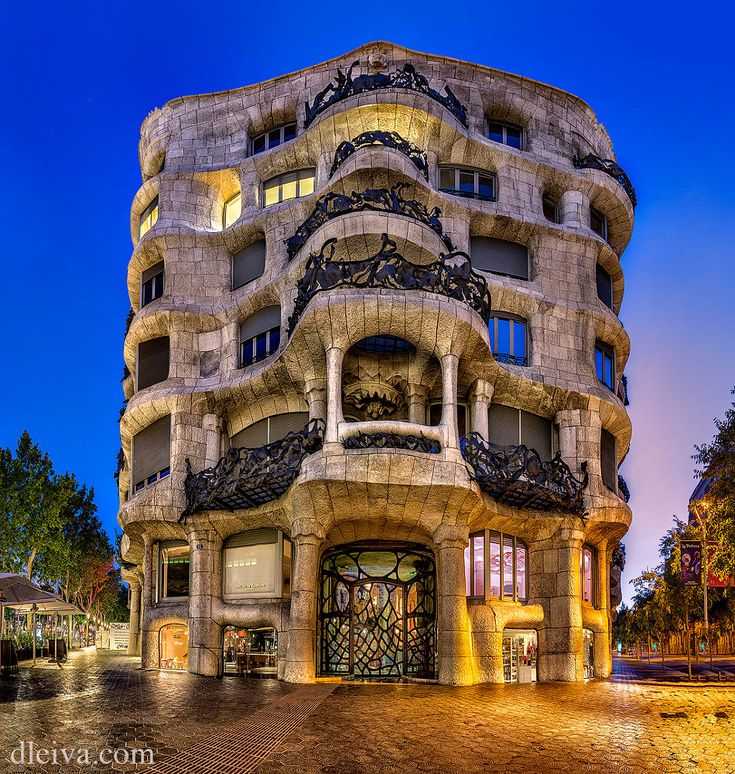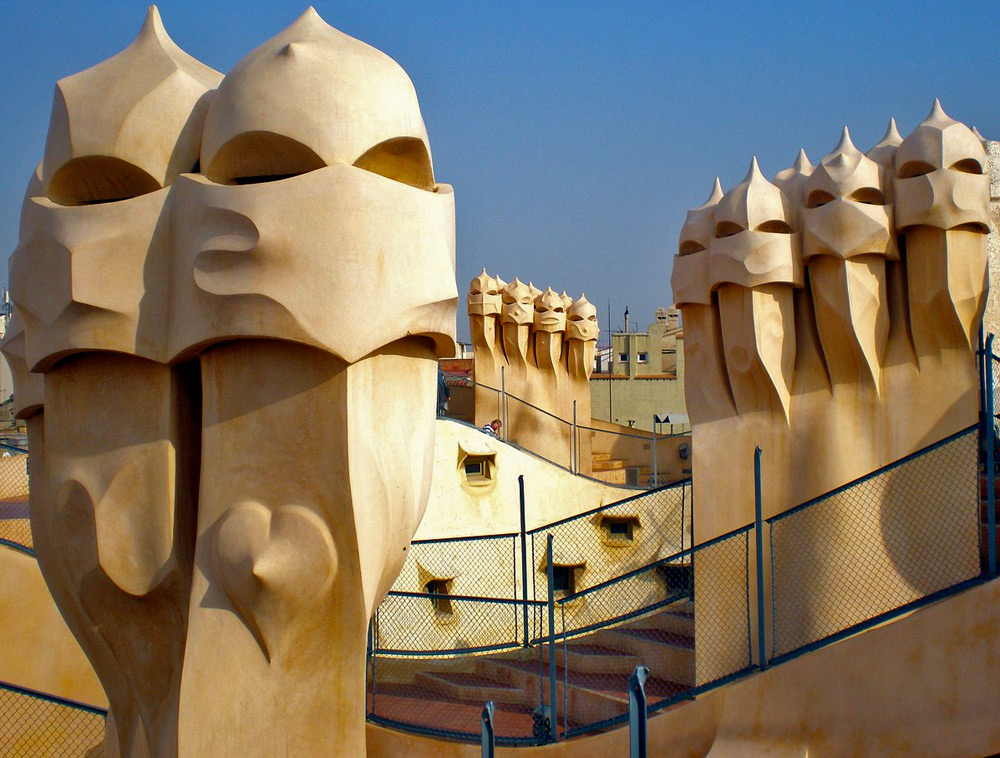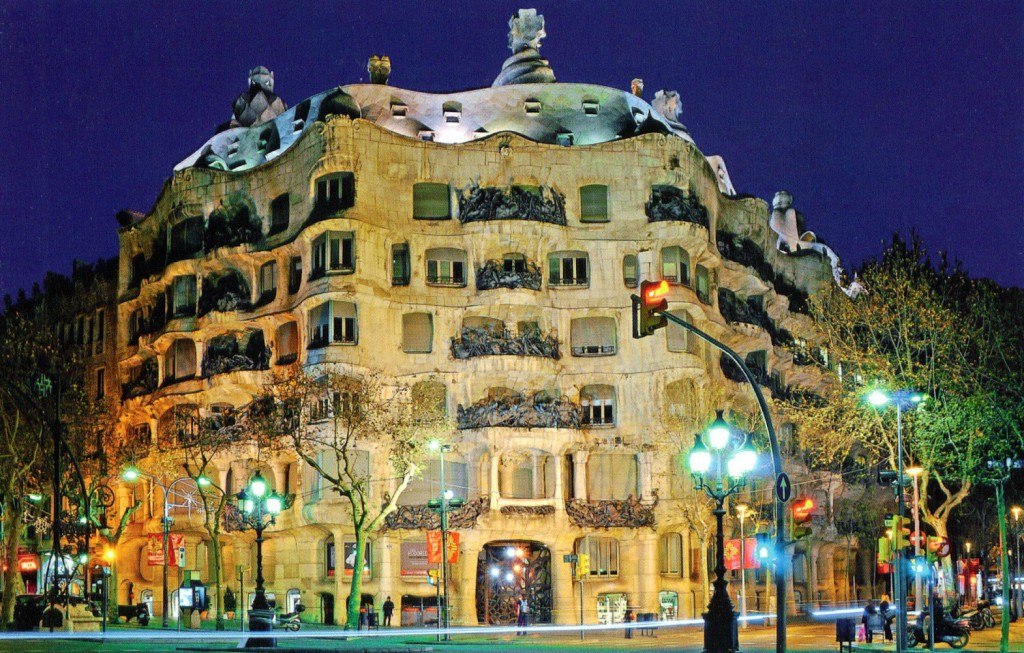The pulsating heart of Gaudí’s Barcelona
Gaudí’s unique Casa Milà was finished in 1910 and because of its inconsistent façade, it is also called la Pedrera which means stone pit. The building is nowadays a World Heritage Site and famous for its unmistakable style. On your visit you can see the extraordinary roof deck with a breathtaking view, as well as the inner court yards and exhibitions inside the house.
The impressive façade
Even from the outside, Casa Mila catches the eye with its undulating façade and curved balconies made of wrought iron. The organic shapes and structures that characterise the building are inspired by nature and give Casa Mila its unique character.
The fascinating interiors
Inside Casa Mila, a world of surprises awaits you. The unique rooms are characterised by curved lines, impressive staircases and refined decorations. Discover the colourful mosaics, magnificent ceilings and the many loving details that bring Gaudí’s vision to life.
The breathtaking roof terrace
An absolute highlight of Casa Mila is the spectacular roof terrace. Surreal chimney figures, organic shapes and a breathtaking view over Barcelona await you here. Enjoy the unique atmosphere and let yourself be enchanted by the beauty of this special location.
Exciting exhibitions and events
Casa Mila also hosts a number of exciting exhibitions and events that take a closer look at the work and life of Antoni Gaudí. Explore the different rooms that host temporary and permanent exhibitions and immerse yourself in the history and art of the era. In addition, Casa Mila regularly hosts cultural events such as concerts and lectures for a varied and inspiring experience.
Highlights of the Casa Milà – La Pedrera
- Impressive façade: The undulating façade and curved balconies made of wrought iron make Casa Mila a distinctive landmark in Barcelona.
- Fascinating interiors: The unique rooms, characterised by curved lines, colourful mosaics and magnificent ceilings, offer a deep insight into Gaudí’s artistic vision.
- Breathtaking roof terrace: The spectacular roof terrace with its surreal chimney figures and breathtaking views over Barcelona is an unforgettable experience for visitors.
- Exciting exhibitions and events: Casa Mila hosts both temporary and permanent exhibitions that take a closer look at the work and life of Antoni Gaudí, as well as cultural events such as concerts and lectures.
- Practical information for visitors: Casa Mila is easily accessible by public transport and has barrier-free access, although it is advisable to book tickets in advance and find out about current opening times and special events.
Opening hours Casa Milà – La Pedrera
March-November
Daily: 9am-8:30pm
From November
Daily: 9am-6:30pm
Restrictions of Casa Milà – La Pedrera
- Tickets: It is recommended to buy tickets online in advance to avoid queues and ensure you have a seat for the time you want. Sometimes tickets bought on site are more expensive than those bought online.
- Security checks: Casa Mila may conduct security checks for visitors. It is advisable not to bring large bags or backpacks as these may have to be handed in at the security check.
- Accessibility: Casa Mila is largely barrier-free, but some areas, such as the roof terrace, may be difficult to access for people with limited mobility. Lifts and ramps are available to facilitate access.
How to get to Casa Milà – La Pedrera by Public Transport
Casa Mila, also known as La Pedrera, is centrally located in Barcelona and easily accessible by public transport. Here are some options to reach Casa Mila by public transport:
Metro: The closest metro station is Diagonal (L3, green line and L5, blue line). From Diagonal station it is only a few minutes’ walk to Casa Mila.
Bus: There are several bus lines that stop near Casa Mila. Lines 7, 22, 24, V15 and h20 are some of the buses that stop nearby. The exact stop can vary depending on the line, but Passeig de Gràcia and Avinguda Diagonal are usually the closest stops.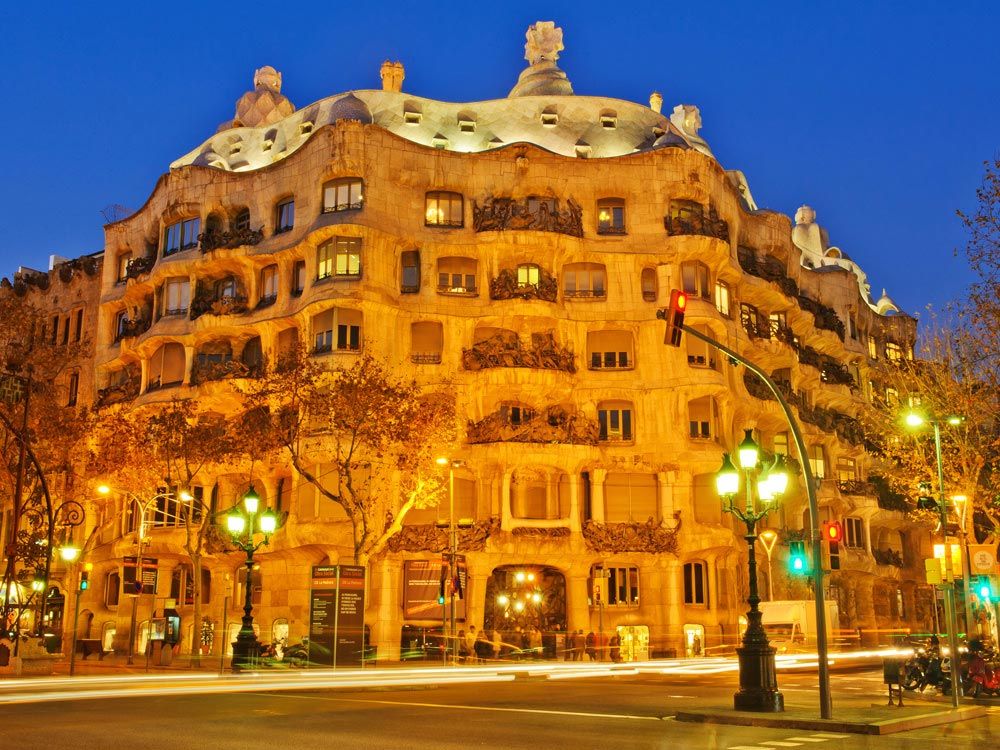
FGC (Ferrocarrils de la Generalitat de Catalunya): The FGC station Provença is also close to Casa Mila. The L6, L7, S1, S2, S5 and S55 lines run here. From Provença station it is about a 5-10 minute walk to Casa Mila.
Address Casa Milà – La Pedrera
Passeig de Gràcia, 92
08008 Barcelona
Click here
to see on google maps
Discover the fascinating world of Casa Mila and immerse yourself in Antoni Gaudí’s breathtaking masterpiece. Let yourself be enchanted by the unique shapes, colours and details of the modernist architecture and experience an unforgettable adventure in the heart of Barcelona. What are you waiting for? Plan your visit to Casa Mila now, secure your ticket online and prepare to immerse yourself in the world of Gaudí’s visionary art!
Casa Batllo Or Casa Mila (La Pedrera): Which Gaudi Building Should You Visit?
by Nele van Hout
Last Updated on February 3, 2023
Which Gaudi house is better, Casa Mila or Casa Batllo? Find out which Gaudi house in Barcelona is worth visiting.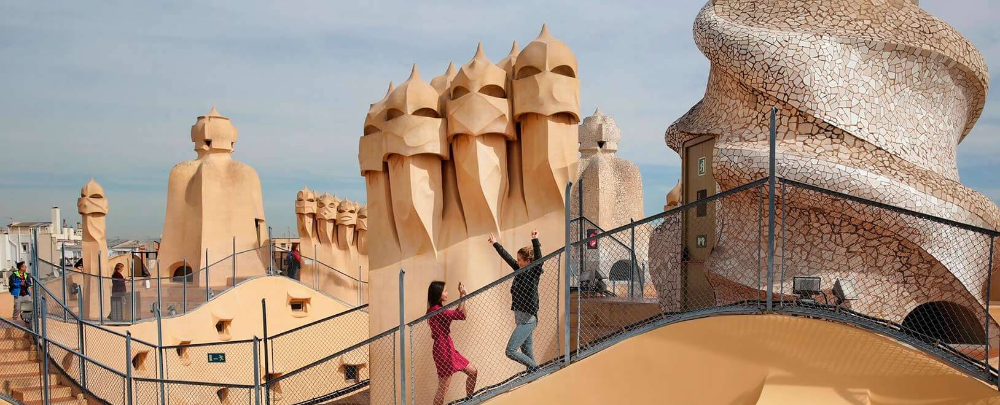
A visit to Barcelona isn’t complete without seeing at least one or two of Gaudi’s masterpieces. Nobody has left a mark on the city quite as much as this Catalan architect. And truth be told, his work is out of this world.
While both Casa Batllo and Casa Mila are incredible pieces of architecture, you may not have the time (or budget) to visit both. It’s not cheap to visit them, and if you’re only in Barcelona for a couple of days, you may not have time to cramp both houses into your itinerary.
In this article, I’ll compare my visits to Casa Batllo and Casa Mila (La Pedrera) to show you which one is better to visit.
Casa Batllo or Casa Mila: Overview
Before we go into more details about both Gaudi houses, here is a quick overview of Casa Batllo and Casa Mila:
| Casa Batllo | Casa Mila (La Pedrera) | |
| Price | From €35 | From €24 (online) / €27 (ticket office) |
| Pros | – Better audio tour – Better overall experience. 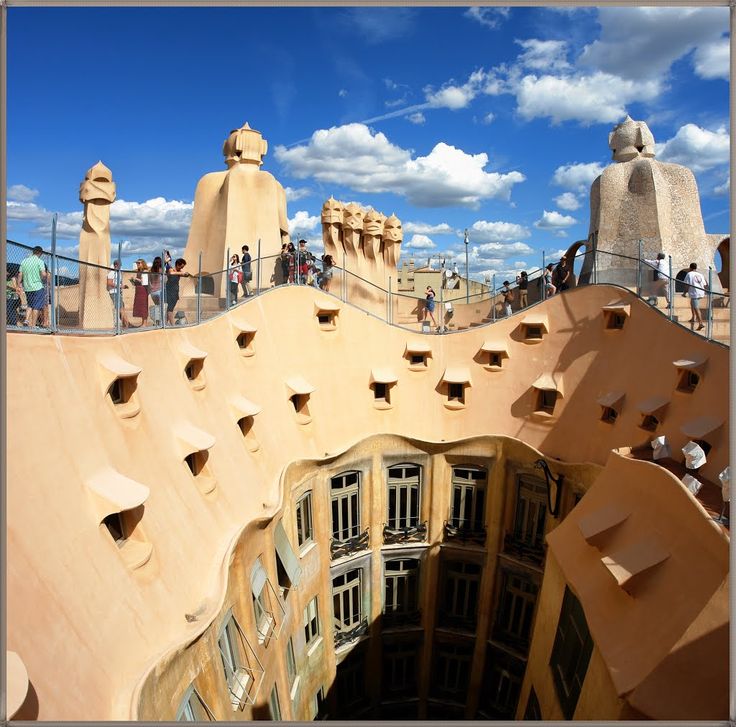 |
– Stunning roof – Exhibition of other Gaudi buildings in the attic. |
| Cons | – Expensive, especially since you can see the outside facade for free. | – Exhibition of what the rooms used to look like felt forced/unnatural. |
| How long does a visit take? | Around one hour | Around one hour |
| Opening hours | Tuesday – Thursday: 9:00 – 18:30 Friday – Monday: 9:00 – 20:00 |
Monday – Sunday: 9:00 – 18:30 |
| Address | Passeig de Gràcia, 43 08007 Barcelona | Passeig de Gràcia, 92 08008 Barcelona |
Is it worth going into Casa Batlló?
If you have the budget, I think it’s definitely worth going inside for the tour.
The exterior of Casa Batllo is definitely one of the most impressive things about this building, and you can enjoy it without paying for an entree ticket. On top of that, there’s no way around the fact that it’s very expensive to go inside.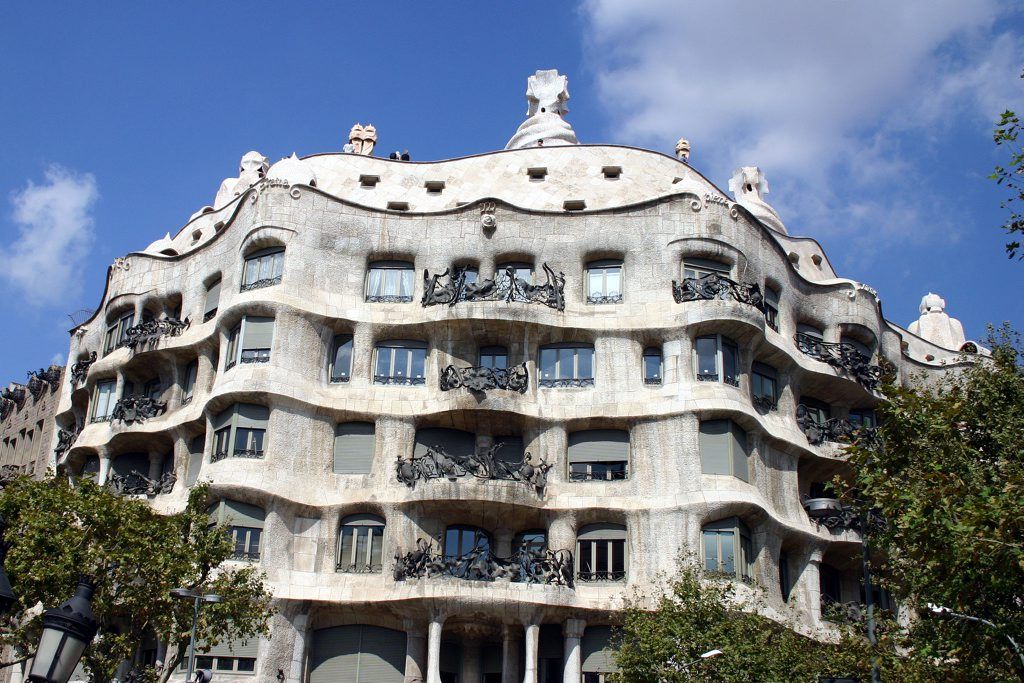
However, I thought the tour through Casa Batllo was simply magical. I enjoyed it way more than the tour of Casa Mila. The audio tour was incredibly thorough and made you feel very connected to the building, its past and the ideas Gaudi had for the beautiful piece of architecture.
On top of that, I preferred the way Casa Batllo looks, inside and outside. It has a much more magical atmosphere than Casa Mila and it felt more natural walking through it.
On the roof of Casa Batllo with the audio tour
Is Casa Mila worth visiting?
Yes, Casa Mila is definitely worth visiting. While I preferred the tour and the interior of Casa Batllo, Casa Mila is magnificent in its own way. One of the main highlights, the rooftop, is out of this world and would definitely add to your trip to Barcelona.
While I thought the exhibitions on how the rooms used to look felt a bit forced, it was nice to walk through the building. The exhibition in the attic about other Gaudi buildings was very interesting, however.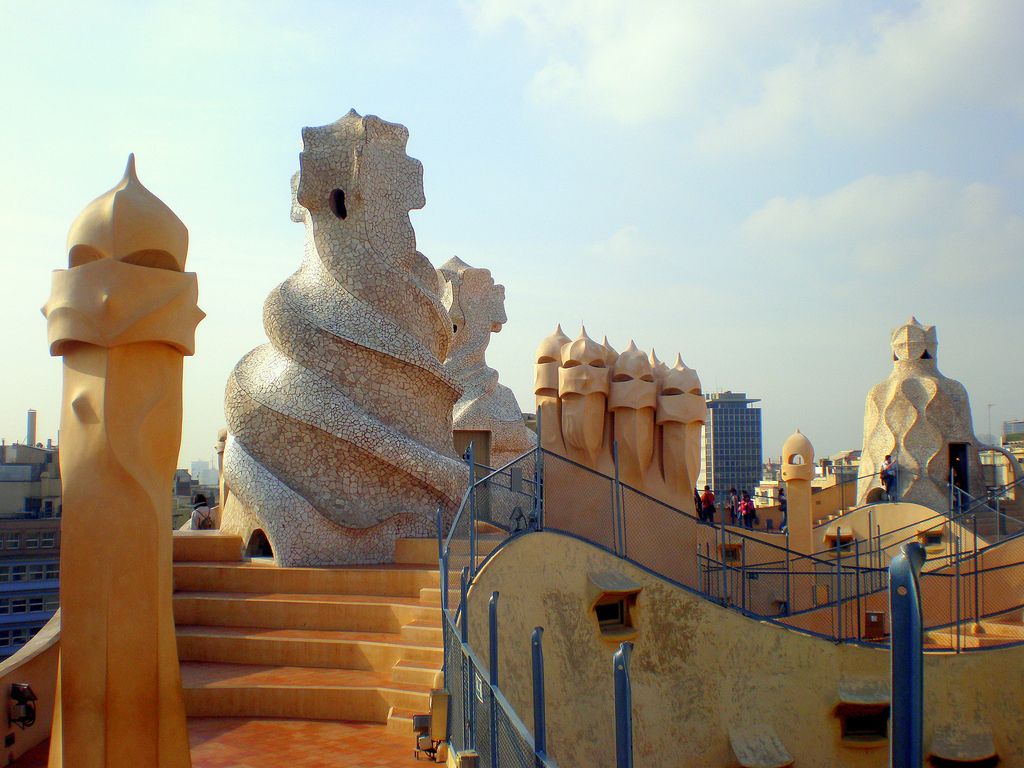
I preferred Casa Batllo, but since it’s way more expensive to visit than Casa Mila, I think this is a great alternative if you only have the time/budget to visit one of Gaudi’s houses.
Which is better, Casa Mila or Casa Batllo? My opinion
If you have the time and budget to visit both, I highly recommend visiting both Casa Batllo and Casa Mila. While they’re definitely not cheap to enter, both give you a very unique and insightful experience into Gaudi’s work.
However, if you can only pick one and your budget allows it, I’d pick Casa Batllo. Even though it’s more expensive, the experience was better than Casa Mila/La Pedrera, in my opinion. While both houses are incredibly impressive, the audio tour was much better at Casa Batllo, and walking through it was also a better experience.
Casa Mila’s tour was good, but I personally didn’t love the displays. I liked that they tried to show what the house would’ve looked like in the past, but it felt a bit too forced.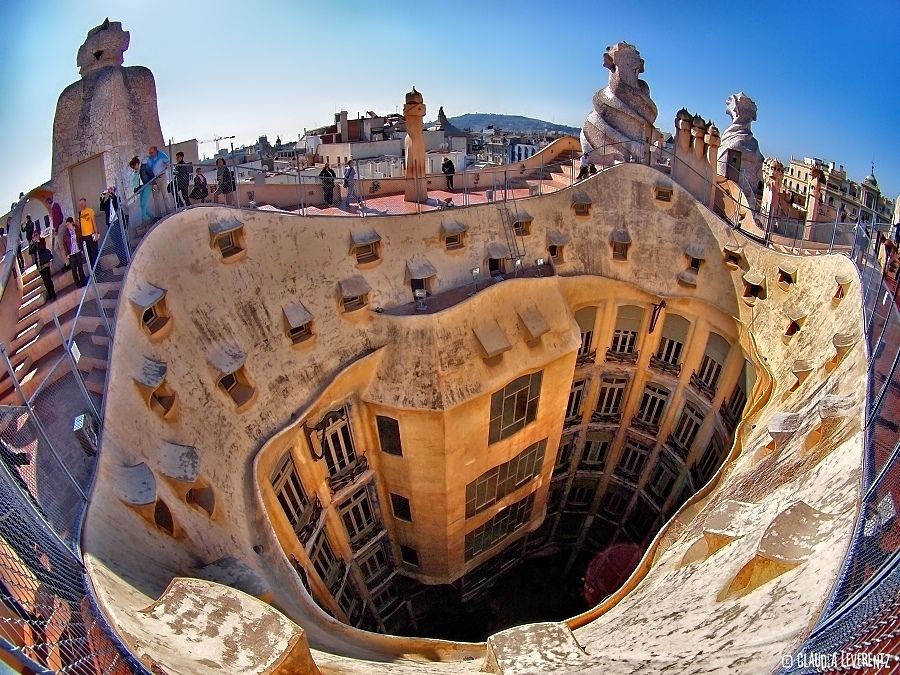
That being said, if you’re not looking to spend €35 to enter Casa Batllo (especially since you can enjoy the outside facade for free), La Pedrera/Casa Mila is a great alternative. The roof of La Pedrera is unmatched by the roof of Casa Batllo, however, the audio tour was less impressive.
I hope this article has given you some insight into which Gaudi house would make for the best addition to your Barcelona itinerary. Visiting both has made me appreciate Gaudi’s work on a whole new level, and I’m sure visiting either of them will have the same effect on you.
- Author
- Recent Posts
Nele van Hout
Nele (Nay-la) has had an interest in Japan and its culture for as long as she can remember. And since her first trip in 2018 surpassed all expectations, she has continued to return to Japan to explore more of all it’s got to offer.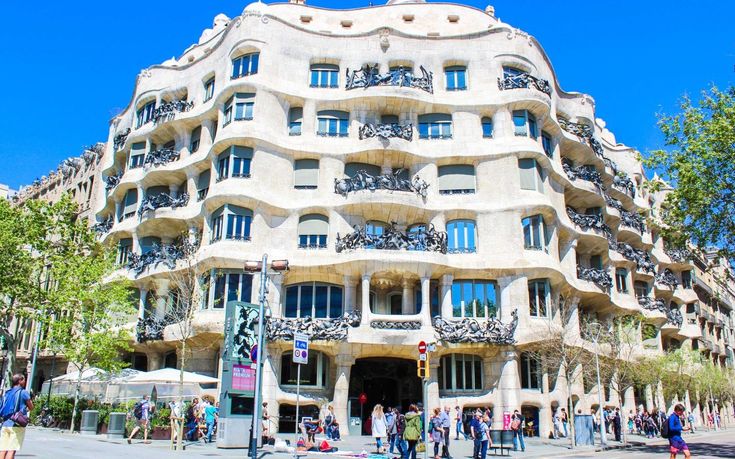
Latest posts by Nele van Hout (see all)
description, address, hours and opening hours 2023
One of the most popular tourist destinations is Dom Mila. Antonio Gaudí became its architect – this was his last work, after which he began the construction of the Sagrada Familia temple.
Location
Passeig de Gracia 92, at the intersection with Carré de Provença
Opening hours
November – February: from 9:00 to 18:30 daily; March – October: from 9:00 to 20:00 daily; Holidays and days off: December 25, 26, January 1, 6 – from 9-00 to 14-00
Website
https://www.lapedrera.com
Address: Provença street, 261- 265, Barcelona
Ticket prices:
Adult ticket €20.50
Students and children from 7 to 12 years old €10.25
Children under 7 are free.
What you need to know about Casa Mila
The house owes its name to the tycoon Pere Mila, who ordered its construction from Antoni Gaudí.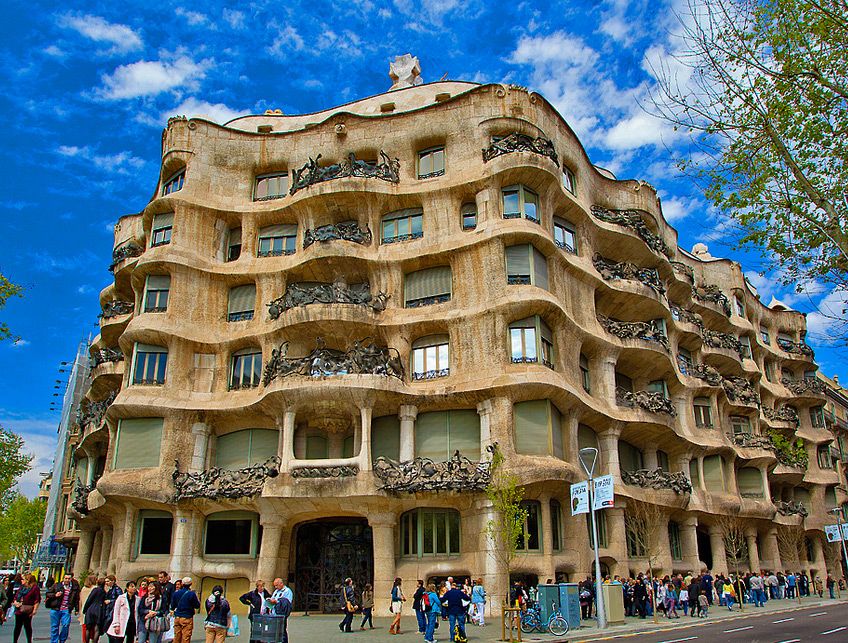
Pere Mila did not make a mistake with the choice of the master. Antonio Gaudí managed to create a work of art that still inspires many modern architects.
The exterior of the building shows the master’s hand — recognizable smooth forms inspired by nature and walls that look more like the walls of a cave than a residential building. There are practically no rough corners in the building – all its details seem to flow down.
Pay special attention to the grilles, which, like the whole house, are made in the form of plants, or rather, seaweed. Their production was carried out by the artist Josep-Maria Jujol.
Balcony grilles. Photo: barcelona10.ru
House tour
Built in 1910, Mila House is still used for its intended purpose. People still live in it, but most of it officially belongs to the bank. But especially for tourists and residents of Barcelona, the Gaudi Museum was opened in the house.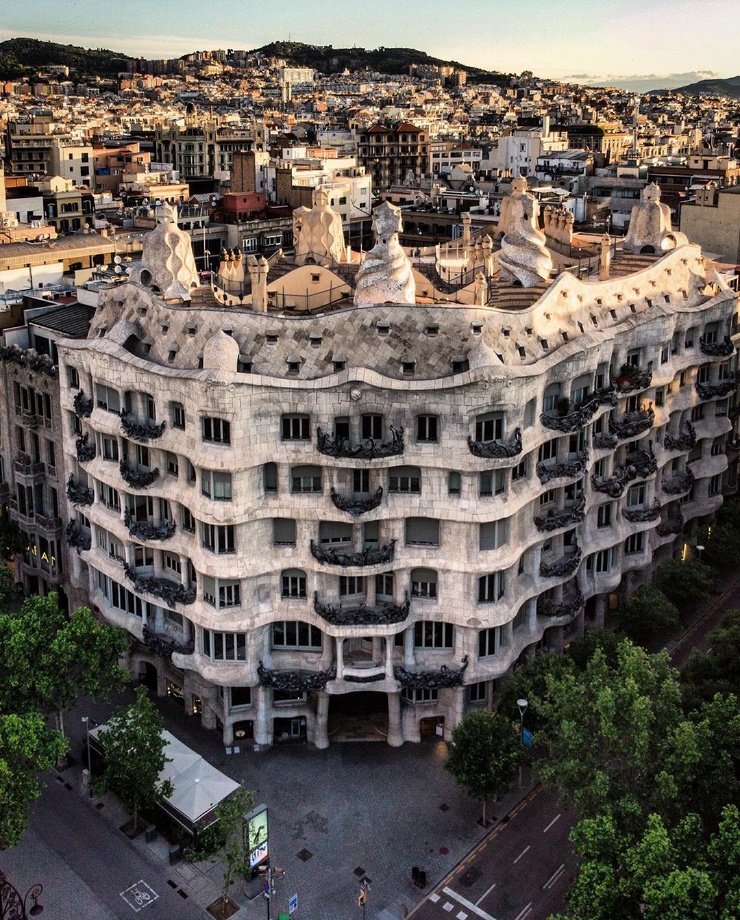
So don’t be shy – come in. The house has three patios. One of Gaudí’s goals was to create a house where all the apartments would have windows facing the street, which was rare for those times. If the residential windows overlooked the street, then the windows of the utility rooms – into the yards.
Be sure to pay attention to the walls of the building – they are painted with all sorts of floral ornaments. The natural theme continues on the roof. Such familiar details of any house as an elevator shaft or pipes look like separate works of art here.
Inside the house. Photo: happyinspain.com
Gaudí Museum
The house houses a small Gaudí museum located in the apartment. In it you will be able to see the layout of the future building, his old photographs, as well as personal items from the architect’s collection that inspired him: sea shells and even animal skeletons.
Here you can also see what the apartment of a representative of the bourgeoisie looked like in the 20th century: a massive bed, a sofa, an old telephone.
What is most interesting is that initially Mila House, which is now known all over the world, did not like the locals at all. To many, it seemed unnecessarily large and pretentious. They even gave him a name that speaks – “The Quarry”. But, then they got used to it, and in 1984 UNESCO included it in the World Heritage List.
The roof of the Mila House. Photo: euromapa.net
How to get there
You can get to Doma Mila by bus or metro.
Buses: 7, 16, 17, 22, 24, 28. Get off at the Provença-La Pedrera stop.
If you are taking the metro, go to the Provença station. The green line L3 or the blue line L5 will suit you.
Casa Milà
Casa Milà is one of the early successful projects of the famous architect Antonio Gaudí, distinguished by its unique architecture, like all the projects of the architect. Casa Mila in Barcelona is considered a real gem of the urban ensemble, which at 19In 84, it became the first building of the 20th century to be included in the UNESCO World Heritage List.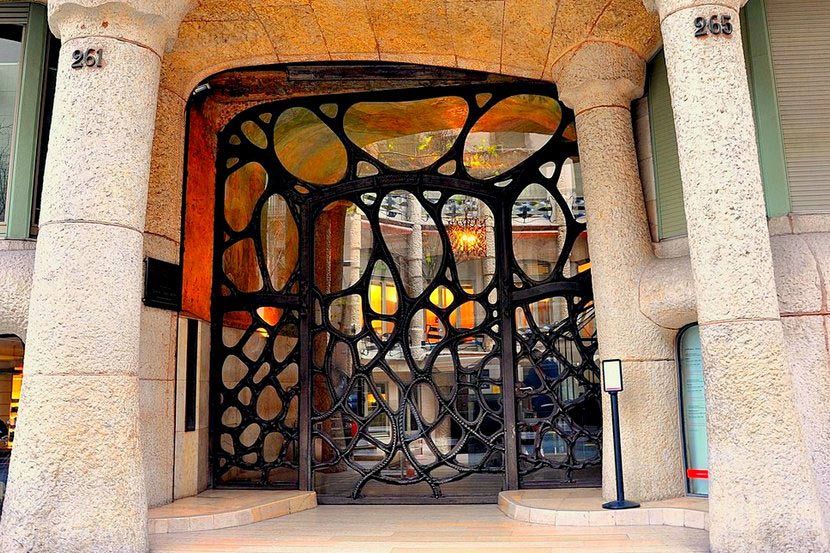
House Mila is an excellent example of Art Nouveau architecture, prescribing unity with the environment and the use of natural motifs.
Construction history
Casa Milà in Barcelona was designed by Antoni Gaudí for the textile magnate and public figure Pere Milà. The construction of the city residence was carried out in the period from 1906 to 1910. A large-scale ambitious project required significant investments, which greatly shook the financial well-being of the Mila family. The building exceeded city standards in terms of height and width, so Pere Mila was regularly fined by Barcelona City Hall. The construction of the House of Mila (Casa Milà) was completed without the participation of Gaudi, due to financial disagreements, in 1909. relinquished control of the work.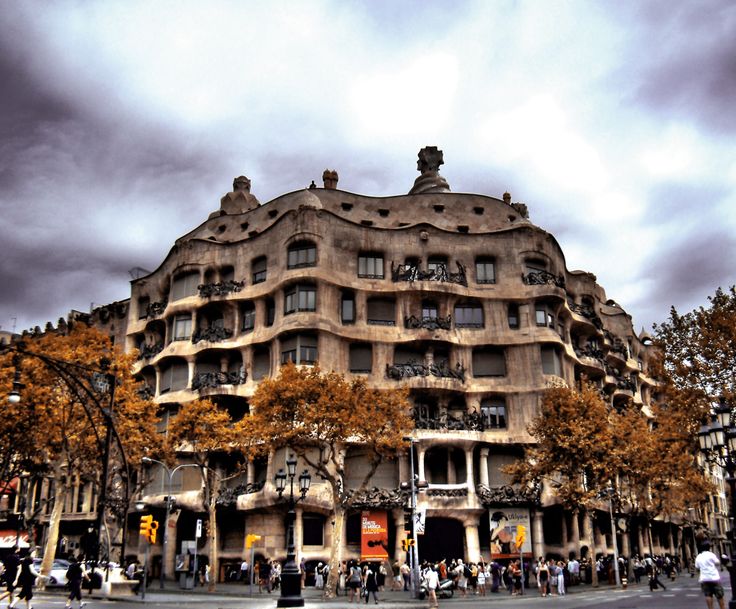
The curved façade of the House of Mila is made of reinforced concrete and limestone blocks, and the balustrades are decorated with wrought iron bars resembling a vine.
Features of the facade design
The architecture of Casa Mila in Barcelona is considered to be one of the most illustrative examples of Art Nouveau. The urban residence of the Mila family consists of 6 floors and one attic tier, above which there is a spacious roof terrace.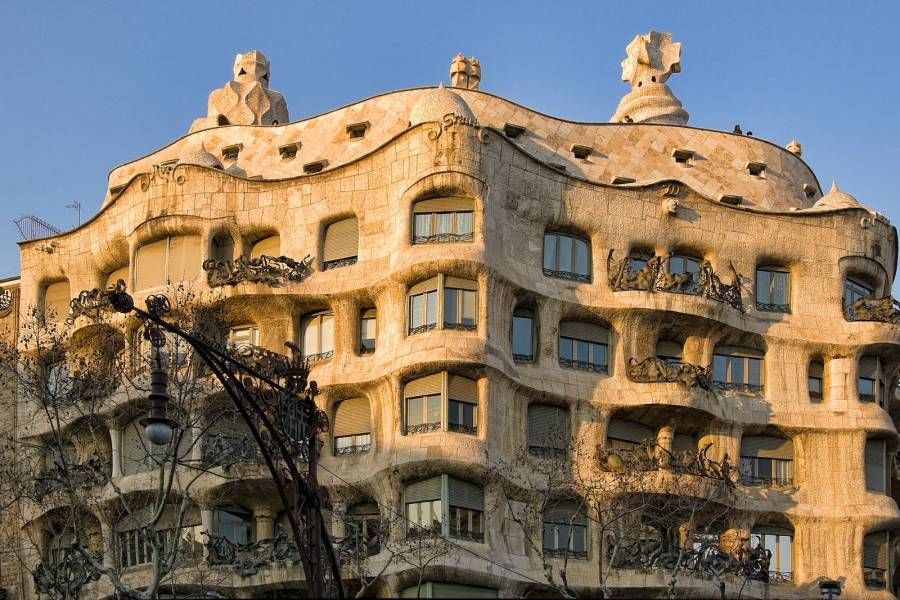
At the base of the upper cornice there are also small stone medallions, and above it there is an attic floor with a row of small dormer windows.
Thanks to the features of a relatively new material for the beginning of the 20th century, reinforced concrete, the architect was able to achieve plasticity of the lines of the facade. Almost the only and very characteristic element of the decor of the Casa Mila are the beautiful wrought iron patterned lattices of the balconies, created by Josep-Maria Giuogol, who maximally conveyed the plant motifs so characteristic of Art Nouveau architecture.

